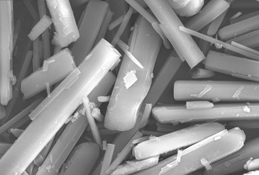 Some scientists
are experimenting with a new form of alchemy — not looking to create a
substance, but rather remove one: carbon dioxide. If their process works, it
could reduce the effects of the greenhouse gas in the atmosphere.
Some scientists
are experimenting with a new form of alchemy — not looking to create a
substance, but rather remove one: carbon dioxide. If their process works, it
could reduce the effects of the greenhouse gas in the atmosphere.The serpentine minerals in this scanning electron microscope image contain sequestered carbon dioxide. Researchers are hoping to use the minerals to remove carbon dioxide from the atmosphere that has been emitted by power plants. Image courtesy of Mercedes Maroto-Valer.
Carbon sequestration, a process that involves removing carbon from power plant emissions or the atmosphere itself, can take several forms. The method currently in favor is underground injection, but it is hard to monitor, and storage space is limited (see Geotimes, March 2003). A more permanent approach uses mafic minerals — minerals with high magnesium and iron content, such as serpentine or olivine — to absorb carbon.
Mafic minerals naturally sequester carbon dioxide, but “it happens very slowly over geologic time,” says Mercedes Maroto-Valer, an energy and geo-environmental engineer at Pennsylvania State University and lead researcher on the project. The goal of her work, as well as other researchers’, is to find the right blend of processes, minerals and chemicals, to make carbon dioxide removal quick, efficient and affordable.
In their method, Maroto-Valer and colleagues dissolve serpentine in sulfuric acid and then pass carbon dioxide through the solution to form magnesium carbonate, better known as magnesite. Power plants using this process could sell the magnesite byproduct to manufacturers to make cinderblocks and other construction materials, Maroto-Valer says, and Penn State has a U.S. patent pending.
Not everyone, however, thinks their invention is the answer to Earth’s carbon dioxide woes. Klaus Lackner, a geophysicist with the Center for Carbon Management at Columbia University in New York, says that the work is building on past experiments and is promising, but still has many barriers to overcome before implementation. “These processes were developed in the 1950s and 1960s,” he says, and “the chemistry we are doing is still very primitive.” As the process becomes more sophisticated, “one can expect to see substantial progress.”
Still, digesting serpentine in a strong acid is “not particularly novel or surprising,” Lackner says. And without a way to recover the spent acid (something the researchers say they are working on), he says, the process is too costly. “The challenge is to recover from the use of a strong acid and find a cost-effective way of converting the salt that just has been formed back into an acid and a base.”
Bill O’Connor, a geologist with the Department of Energy’s Albany Research Center in Oregon, who has experimented with several silicates and solution chemistries (including carbonic acid, a much weaker acid), says that “using a coarser particle size could dramatically reduce the cost.” In his research, finely grinding the ore, which speeds up the reaction, accounts for 75 percent of the cost, he says.
Thermodynamics aside, the Penn State process would require enormous amounts of serpentine, O’Connor says. “You need seven times the mass of serpentine for every unit mass of coal,” he says. There would therefore be significant mining impacts.
Many of the carbon disposal methods are pitting one environmental problem against another, Lackner says, but “we need to start dealing with carbon dioxide now.” Management of carbon dioxide requires keeping it out of both the oceans and the atmosphere, he says, and the use of mafic minerals is one of the best ways to accomplish that. With the right processes, Lackner says, “we will have a sink for carbon dioxide bigger than the largest estimates of what we could ever put out.”

